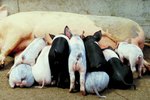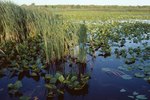
Pig frogs and bullfrogs are two closely related species that greatly resemble each other. Their geographic ranges overlap, making identification no simple thing. Several physical characteristics separate the two species, though; they include their snouts, colors, sizes and calls.
Color
Most bullfrog specimens are plain green above with lighter-colored bellies, though some may have meshlike patterns of gray or brown laid over a green background. Some populations, particularly those in the southeasternmost parts of their range, have patterns of dark gray, brown and black. The pig frog, on the other hand, is most often grayish-green to brown with mottled black spots. Some specimens may have spots on the legs.
Size
Both species are particularly large -- the bullfrog is the largest frog in the United States, 3 1/2 to 8 inches long; the pig frog is only slightly smaller, reaching maximum lengths of about 6 1/2 inches. Because size varies greatly for both species, it is not a distinguishing characteristic most of the time, as some pig frogs may be larger than some bullfrogs.
Other Physical Characteristics
Pig frogs have more webbing. The webbing of bullfrogs' toes does not go to the end of the toes as it does in pig frogs. The snout also differs between the two: the pig frog has a noticeably pointy snout compared with the rounded snout of the bullfrog. The tympanum is typically much more conspicuous in pig frogs, as well, although bullfrogs also have prominent tympanums. The call of each frog is different: The pig frog has a piglike grunt, hence its common name; the bullfrog's deep call is described as "jug-o-rum" on the University of Georgia at Savannah's River Ecology Lab website.
Range and Habitat
Pig frogs have a less extensive range than bullfrogs, inhabiting Florida and the coastal plains of Georgia and South Carolina. The bullfrog, on the other hand, has a broad range covering most of the Southeast, the Midwest and the central states. The bullfrog is an introduced species in many other areas, as well. Both prefer permanent bodies of water, particularly ponds; the pig frog is much more aquatic than his slightly larger cousin.
References
Resources
Photo Credits
-
Hemera Technologies/Photos.com/Getty Images
Writer Bio
With a professional background in gardening, landscapes, pests and natural ecosystems, Jasey Kelly has been sharing her knowledge through writing since 2009 and has served as an expert writer in these fields. Kelly's background also includes childcare, and animal rescue and care.




